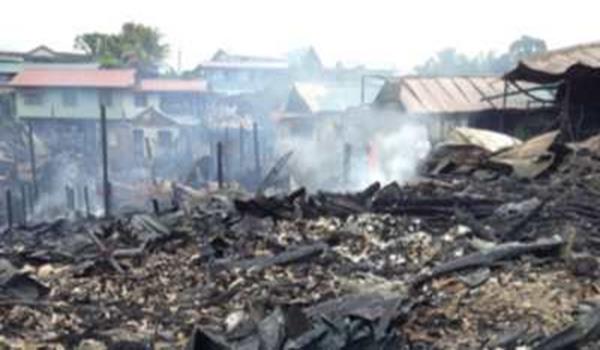Early Iban Pioneers of the Krian Region.
The early Iban pioneers who came to explore and settle the Krian region were originally from what is now the Saribas District. Many of them were at one time or another, Paku settlers. They pushed their routes to the Krian River via the Rimbas. Some of them took the lower route, starting from Sekundong or Kerangan Pinggai, Paku, transversed the Rimbas region of Debak, Deit, Belasau, Undai and Rapong to the Melupa where they continued their migration by boats sailing down the river. In Melupa these pioneers settled permanently, while some others pushed, on to the Awik, Sebetan and Sabelak region.
Other pioneers such as Radin took the middle route setting out from Samu, Paku. When they reached the Rimbas at Tembawai Surok Lelabi in the Teru, they wound their way up the river and then crossed to the Krian side at Bayor. On reaching Penajar Mountain the party split up. One party went downriver to explore the Kawang and Batang Rimbas until they came to Gerenjang, a tributary of the Upper Krian. Other parties explored the regions of Babang and Pilai. The pioneers of the Pilai followed the course of that river and finally settled at Nanga Maras, Krian.
Some explorers and pioneers started from Samu and Anyut migrating up the Paku River itself to the vicinity of Meroh where they turned to the left, going up the Ketoh River, a small tributary of the Paku until they reached its source, Mount Medang, the place where Linggir “Mali Lebu” encountered the spirit of Enting Naing in the form of a snake (ular kendawang). They ascended this mountain and settled on the other side of it, at the Upper Gerenjang. Others continued on to the Upper Krian and Awas.
(a) The Melupa Region.
After Daji’s victory over the Seru at Nanga Diso, where the Seru leader, Genalus, was killed by Nanggai of the Rimbas, more and more Iban came from the Saribas to occupy the Krian.
The region of the Melupa was perhaps first permanently settled by the immigrants led by Daji and Gila who used the lower route. They penetrated to the Melupa via the virgin jungle covering Sibirong Mountain, the source of Sulau River, a tributary of the Assam River, in the Melupa. Since their penetration was by way of the Sibirong, clearing the jungle to farm the land as they went, the mountain is also known as Sibirong Pesok. “Pesok” means to break through or penetration. In the course of their migration, they settled at the Sibirong for awhile. Later, Unggang “Kumpang Pali” led another party from the Saribas to the Krian via the Undai of the Rimbas and down the Melupa. He and his followers finally settled at Temudok on the middle Krian region.
(b) The Awik Region.
About three generations after the Iban had occupied the Krian River, Enchana “Letan Pulas Emas” and Penghulu Penghulu Minggat and their followers, decided to migrate from Paku region to the Krian region. At first they decided to settle in the Krian, but Gila, veteran of the last tribal war against the Sera at Nanga Diso, would not approve of this. Thus Letan and his party entered the Awik and built a longhouse at Rantau Menukol, located below Nanga Malong. From there they moved upriver at Lubok Kepayang.
Later when Penghulu Minggat came with his followers, he settled at Nanga Mitas, where he built a 60-door longhouse. The descendants of Penghulu Minggat now live in Kamidan, just above Nanga Mitas.
(c) The Sebetan Region.
Sebetan was pioneered almost simultaneously with Awik by Bir, one of Linggir “Mali Lebu” young warrior from Sekundong, Paku. He wanted to follow Penghulu Minggat and his party. But the latter dissuaded Bir from following him for fear that the Awik would soon become overcrowded. Penghulu Minggat permitted him to proceed upriver only to Nanga Stingam, where Bir made up his mind to find another place to live.
Incidentally, Bir, on a hunting expedition, followed the course of Sungai Manding, a small tributary of the Awik, to its source. At its headwaters, he found another stream flowing in a different direction. He named it Sungai Berangan for there were many berangan trees growing on either bank of the stream. When he returned to his house at Nanga Stingam, he took some of his men to explore more of the region of Sungai Berangan and the main river where it branches out. Apparently the stream empties into the Sebetan River, whose mouth is below the modern town of Saratok.
Afterwards Bir went down the Sebetan to its mouth where he observed bird-omens for seven days. While doing this, he saw a barking deer (kijang) swimming in the river. He knew that this omen was bad. But he was determined to have the Sebetan as his new place of settlement. Bir took all his followers from Nanga Stingam, Awik, to occupy the Sebetan. They built their first longhouse at Pengkalan Rumput (Grassy Landing Place). Later they moved on to Tembawai Emperan. Then they moved to Tembawai Panjai, where the main party split into three groups. These groups built their longhouses at Tembawai Lukut, Tembawai Ngitar and Tembawai Rungan.
Thus Bir became the founder of the Sebetan settlements. When he died he was greatly honoured in that his coffin was not buried but was placed on a platform or lumbong. Bir’s lumbong is still intact on the Naas range (Tinting Naas) near the longhouse of the Honourable Datuk Edmund Langgu, former Member of Parliament, at Sungai Klampai, Sebetan. The remains of Bir’s bones can still be seen there, inside a jar.








